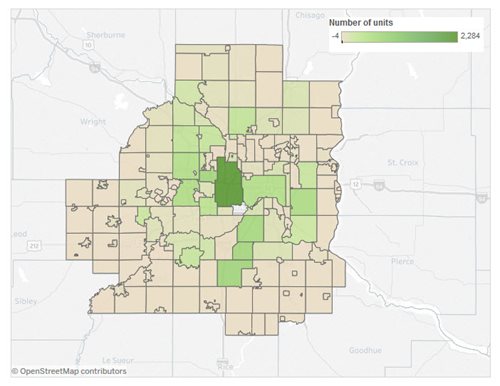Multi-family construction continues to lead
Data from a recent annual survey of building permits shows that residential construction continues to increase, but not quickly enough to keep up with household growth.
 Communities in the region permitted 15,226 net housing units in 2017, the most since 2005 and surpassing 2016 by 11%. That’s nearly 2,500 units more than the annual average of 12,733 units per year since 2000.
Communities in the region permitted 15,226 net housing units in 2017, the most since 2005 and surpassing 2016 by 11%. That’s nearly 2,500 units more than the annual average of 12,733 units per year since 2000.
Looking at new construction only (not accounting for demolitions and other kinds of housing-related permits), communities permitted 15,652 housing units; on par with the annual average of 15,319 units per year since 1970.
The majority of these, 60%, were multifamily units—consistent with the Council’s long-term expectations.
Minneapolis outpaced other cities, with 2,284 additional units permitted in 2017. However, residential development continues to be distributed across the region, with growth strong in both the developed core and the developing edges of the region.
Construction of townhomes, duplex/triplex/quadplex units, and alternative dwelling units, all of which are seen as relatively affordable options, has been slow.
Later this year, Council Research will add data on the affordability of these permits.
Vacancy rates low, homes priced below $200,000 in short supply
-
Low vacancy rate, with demand outstripping supply, of 4%. To achieve a healthier vacancy rate of 5%, the region would need an additional 13,400 housing units—a full year’s production.
-
Rising sale prices and rents.
-
Relatively few existing homes for sale, especially homes below $200,000.
-
We’re not alone; 9 of 11 peer cities are not building enough housing to keep up with population growth.
The region’s relatively low housing costs have long been a competitive advantage over other metro areas and a key component of the region’s quality of life. To maintain the region’s prosperity and livability, the region needs more housing, including affordable housing, since rising housing costs hit low-income households the hardest.
Note: Residential permits reflect all kinds of development--new housing, demolition of housing, remodeling that adds or subtracts housing units, and conversion of housing to or from commercial uses (e.g., warehouses, factories).